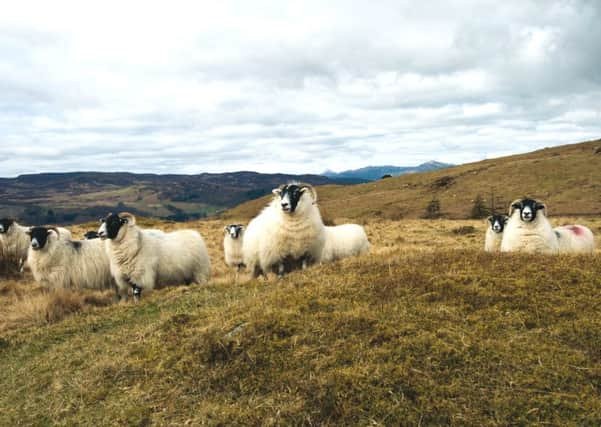Animal welfare pays dividends for Scottish farmers


Lamb from Scotland is famed around the world for its quality and taste but, surprisingly, it remains something of a hidden gem in our country’s larder.
According to Jim McLaren, chairman of Quality Meat Scotland (QMS), there is huge scope for many more Scots to be enjoying this wonderfully natural product, produced to a very high standard right on their doorsteps.
Advertisement
Hide AdAdvertisement
Hide AdDuring the next few months QMS will be promoting that message, along with the simplicity and speed of cooking with Scotch Lamb, as part of a Scotland-wide awareness raising campaign.


This is the time of year when lamb produced in Scotland is at its most plentiful and, with Scots only consuming around half the UK average, the QMS “Wham Bam Lamb” campaign is set to raise the game.
“A key misconception which our campaign will be tackling is that lamb is slow or somehow difficult to cook,” says McLaren.
“In fact, there are loads of great quick easy recipes – from lamb meatballs to stir fries – which busy families can rustle up for a tasty mid-week meal.”
Scotch Lamb has the accolade of being one of the first meats in Europe to be granted the much-coveted European Protected Geographical Indication (PGI) status and the well-recognised blue rosette logo is accompanied by the distinctive yellow PGI logo. To be eligible to carry the Scotch Lamb brand, lamb must be produced in a way which meets the stringent criteria of QMS’s quality assurance schemes.


These not only cover on-farm production, they include areas such as haulage, auction markets and processors. The welfare of animals is a priority in these schemes.
“Animal welfare is crucial and what sets Scotch Lamb apart is that our assurance schemes cover not only the standards on the farm but also aspects such as haulage, auction markets and, ultimately, the abattoir,” says McLaren.
QMS works with the Scottish SPCA on the delivery of its schemes. “We have a formal partnership with the Scottish SPCA and an Animal Welfare and Wellbeing Charter and we view this commitment to welfare as really important,” he adds.
Advertisement
Hide AdAdvertisement
Hide AdAnother important message which McLaren points to is the very positive sustainability story behind the Scotch Lamb brand.
“Lamb in Scotland is produced in a way which promotes environmental, economic and social sustainability,” he says.
He points to three aspects of environmental sustainability – carbon capture, protein diversion and water diversion.
These, he maintains, are key parts of the story of Scotch Lamb and run alongside the skills and commitment of the men and women who work all year round to produce it.
Around 85 per cent of Scotland’s agricultural land is suitable only for grass and rough grazing and hill and upland farms play a substantial role in improving the environment and maintaining Scotland’s landscape.
Through a process called carbon sequestration, the growing of grass removes carbon from the air and locks it up in the soil.
“These huge areas of land in Scotland can’t be used to grow vegetables or cereals for human consumption but they can be used to grow grass, hence we are maximising the efficient use of all of our land while not diverting protein grown on arable land that we could be using to feed ourselves,” says McLaren, who farms beef cattle near Crieff in Perthshire.
“Farmers are using land that you couldn’t grow anything else on, to produce high-quality meat for us to eat in the form of Scotch Lamb or Scotch Beef.”
Advertisement
Hide AdAdvertisement
Hide AdThe third aspect – water diversion – is something that actor, businessman and former governor of California Arnold Schwarzenegger has been vocal about over the years.
McLaren explains: “A lot of the red meat production in California involves taking water from deep underground to water maize crops for animal feed and that is not sustainable.
“In Scotland the story is very different. It rains a lot and our livestock are simply using the water as it flows from the hills on the way to the sea and none of that is being diverted from human requirements at all.
“People can enjoy Scotch Lamb knowing it has been farmed in a way that makes a positive contribution to our environment.”
Livestock production has played a key role in Scotland’s social heritage for centuries, with cattle and sheep farming at the heart of rural communities, and around 50,000 jobs depend on the Scottish red meat industry across all stages of the supply chain.
Farms often pass down from one generation to the next with knowledge of the terrain and age-old techniques just as important as assets transferred within the family.
For new entrants into agriculture, McLaren says sheep farming can also be a good place to start. “For a farmer starting off, one of the best ways into agriculture is to get some sheep.”
QMS also devotes considerable resource to an education programme, which dovetails with the Scottish Government’s strategy to encourage healthy eating and healthier lifestyles.
Advertisement
Hide AdAdvertisement
Hide Ad“We should all be following a healthy, balanced diet with a good source of protein and QMS has a health and education team who work hard to explain the importance of a healthy diet and the role of red meat in that,” says McLaren.
“We do a lot of work in schools to help children understand where their food comes from and we work closely with the Royal Highland Education Trust which does great work on that area.
“We provide them with information on the red meat industry in Scotland and we give kids the chance to cook with red meat.
“Many children in schools today won’t see red meat cooked from scratch at home, ever.”
Last year’s Wham Bam Lamb campaign was supported by double Olympic gold medallist Rebecca Adlington. The busy working mother relied on a diet rich in lean, red meat during her time as an elite swimmer and she was happy to highlight the importance of QMS’s School Meat Voucher Scheme.
This initiative was launched in response to concerns that tight budgets mean many Scottish schools are unable to afford fresh, red meat products for cookery lessons.
McLaren says QMS will continue to work hard to inspire Scottish consumers about lamb and how simple and quick it is to cook.
“There are some old wives’ tales around lamb and people think it is difficult to cook or time consuming. It is, in fact, very simple to cook.
Advertisement
Hide AdAdvertisement
Hide Ad“There is a lot more scope for us to eat Scotch Lamb, particularly when it is produced on our doorstep to such a high standard.”
This year’s awareness-raising campaign from QMS starts this month, running until October, to champion the meat.
A proven success, Wham Bam Lamb saw Scottish-origin sales of lamb in Scotland increase by 10.5 per cent during the campaign in 2016, while Scottish origin lamb commanded a retail price premium of 11 per cent.
The value of this strong performance becomes apparent when set against a declining British market generally, with overall sales of lamb decreasing by 10.7 per cent across the UK. “We are very excited about this year’s campaign,” says McLaren.
“A lot of people think Easter is the time to eat lamb, but much of the lamb on the shelves at that time is not from Scotland.
“Our campaign this year is launching this month because summer and autumn is when Scotch Lamb is at its very best.
“It will include sampling activities around the country which I think is a very important opportunity to showcase quick, modern, tasty Scotch Lamb.
“The campaign will also see farmers involved in encouraging the public to rediscover lamb. You can’t get a better ambassador for lamb than a Scottish sheep farmer.”
Advertisement
Hide AdAdvertisement
Hide AdThe 2017 campaign is predicted to reach close to 90 per cent of adults in Scotland, raising the profile of the product and inspiring more and more people to serve it up at home.
“What we are doing in Scotland is particularly high quality,” says McLaren.
“You will not come across a more natural product produced to such a high standard anywhere in the world than our Scotch Lamb.
“Proud and passionate are probably the best words to describe Scottish sheep farmers.
“We are committed as farmers and as an industry to produce high-quality lamb and beef for consumers in Scotland.”
A matter of quality
– In Scotland, the water sheep and cattle drink is not diverted from human use, thanks to the ample supply of rain. The average rainfall in Scotland is 1,602.6mm compared with 1,129.2mm in England.
– Scotland’s hill livestock farmers typically farm cattle and sheep – the mixed grazing system benefits landscape biodiversity.
– Hill and upland farms play a substantial role in improving the environment through the removal of carbon dioxide from the atmosphere.
Advertisement
Hide AdAdvertisement
Hide Ad– Animal welfare is a priority. The industry works closely with the Scottish SPCA and inspectors from the charity regularly visit livestock farms.
– Around 50,000 jobs depend on the Scottish red meat industry, with many sustaining employment in fragile rural communities.
– Quality Meat Scotland works with the Royal Highland Education Trust to encourage better understanding of livestock farming and beef and lamb production.
– Scottish red meat (beef, lamb and pork) production contributed more than £2 billion to Scotland’s economy in 2011, with beef production the single biggest contributor to Scottish farm output.
– More than 90 per cent of farmers and abattoirs in Scotland are members of assurance schemes which ensure the highest welfare standards.